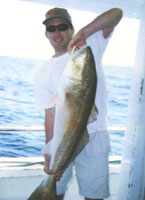 |
William Kenney Associate-In Geological Sciences LUECI Research Scientist Phone: (352) 392-8664 |
William Kenney has specialized in the use of nutrient chemistry (carbon, nitrogen, phosphorus, and silica) in the evaluation of anthropogenic impacts on aquatic ecosystems. His work includes studies of water column processes and sediment biogeochemistry. Water column studies focus on the impacts of anthropogenic nutrient loads on primary production and primary producer community structure in shallow Florida lakes. He uses biogeochemical and radiometric analyses of sediment core samples to investigate the long-term influence of nutrient enrichment on lakes.
Selected Recent Publications:
Kenney, WF, Whitmore TJ, Buck DG, Brenner M, Curtis JH, Di JJ and Schelske CL (2014) Whole-basin, mass-balance approach for identifying critical phosphorus-loading thresholds in shallow lakes. Journal of Paleolimnology. DOI 10.1007/s10933-014-9771-9 (PDF)
Winston, B, Hausmann S, Escobar J, Kenney WF (2014) A sediment record of trophic state change in an Arkansas (USA) reservoir. Journal of Paleolimnology. 51:393-403 (PDF)
Brenner, M and WF Kenney (2013) Dating Wetland Sediments in: Methods in Biogeochemistry of wetlands. Edited by RD DeLaune, KR Reddy, CJ Richardson and JP Meginigal. Published by Soil Science Society of America, Inc. Madison, Wisconsin, USA (PDF)
Sickman, JO, DM Bennett, DM Lucero, TJ Whitmore and WF Kenney (2013) Diatom-inference models for acid neutralizing capacity and nitrate based on 41 calibration lakes in the Sierra Nevada, California, USA. Journal of Paleolimnology. 50:159-174 (PDF)
Pampush, JD, AC Duque, BR Burrows, DJ Daegling, WF Kenney and WS McGraw (2013) Homoplasy and thick enamel in primates. Journal of Human Evolution. 64: 216-224 (PDF)
Day, MB, DA Hodell, M Brenner, HJ Chapman, JH Curtis, WF Kenney, AL Kolata and LC Peterson Paleoenvironmental history of the West Baray, Angkor (Cambodia) Proceedings of the National Academy of Sciences 2012 109 (4) 1046-1051; published ahead of print January 3, 2012 doi:10.1073/pnas.1111282109 (PDF)
Torres, IC, PW Inglett, M Brenner, WF Kenney & KR Reddy. 2012. Stable isotope (d13C and d15N) values of sediment organic matter in subtropical lakes of different trophic status. Journal of Paleolimnology. 47: 693-706. (PDF)
Day, MB, Hodell, DA, Brenner, M, Curtis, JH, Kamenov, GD, Guilderson, TP, Peterson, LC, Kenney, WF and Kolata, AL. 2011. Middle to late Holocene initiation of the annual flood pulse in Tonle Sap Lake, Cambodia. Journal of Paleolimnology. 45: 85-99 (PDF)
Kenney, W.F., M. Brenner, J. Curtis, C. Schelske. 2010 Identifying sources of organic matter in sediments of shallow lakes using multiple geochemical variables. Journal of Paleolimnology. 44:1039-1052. (PDF)
Claire L. Schelske, Eugene F. Stoermer, William F. Kenney. Historic low-level phosphorus enrichment in the Great Lakes inferred from biogenic silica accumulation in sediments. Limnol. Oceanogr., 50(5), 2005, 000–000. (PDF)
Schelske, CL, EF Lowe, WF Kenney, LE Battoe, M Brenner and MF Coveney. (2010) How anthropogenic darkening of Lake Apopka induced benthic light limitation and forced the shift from macrophyte to phytoplankton dominance. Limnology and Oceanorgaphy. 53: 1201-1212 (PDF)
Van Eaton, AR, Zimmerman, AR, Jaeger, JM, Brenner, M, Kenney, WF and Schid, JR. 2010. A novel application of radionuclides for dating sediment cores from sandy, anthropogenically disturbed estuaries. Marine and Freshwater Research. 61:1268-1277 (PDF)
Escobar, J, M Brenner, TJ Whitmore, JH Curtis, and WF Kenney. 2008. Thecamoebians as bioindicators in Florida lakes. Journal of Paleolimnology. DOI 10.1007/s10933-008-9195-5. (PDF)
Frost, JR, EJ Phlips, R Fulton III, CL Schelske, W Kenney, and M Cichra. 2008. Changes in trophic state parameters over a 21-year period in a hypereutrophic lake, Lake Griffin, Florida, USA. Fundamental and Applied Limnology 172:263-271. (PDF)
Claire L. Schelske, Edgar F. Lowe, Lawrence E. Battoe, Mark Brenner, Michael F. Coveney and William F. Kenney. Abrupt Biological Response to Hydrologic and Land-use Changes in Lake Apopka, Florida, USA. Royal Swedish Academy of Sciences 2005 Ambio Vol. 34, No. 3, May 2005 (PDF)
Kenney W.F., C. L. Schelske, and Andrew D. Chapman. Changes in polyphosphate sedimentation: a response to excessive phosphorus enrichment in a hypereutrophic lake. Can. J. Fish. Aquat. Sci. 58: 879–887 (2001) (PDF)
Kenney, W.F., M.N. Waters, C.L. Schelske, and M. Brenner. 2002. Sediment records of phosphorus-driven shifts to phytoplankton dominance in shallow Florida lakes. Journal of Paleolimnology 27: 367-377. (PDF).
Shumate, B.C., C.L. Schelske, T.L. Crisman, and W.F. Kenney. 2002. Response of the cladoceran community to trophic state change in Lake Apopka, Florida. Journal of Paleolimnology 27: 71-77. (PDF).
Kenney, W.F., C.L. Schelske, and A.D. Chapman. 2001. Changes in polyphosphate sedimentation: a response to excessive phosphorus enrichment in a hypereutrophic lake. Canadian Journal of Fisheries and Aquatic Sciences 58: 879-887.
Schelske, C.L., and W.F. Kenney. 2001. Model erroneously predicts failure for restoration of Lake Apopka, a hypereutrophic, subtropical lake. Hydrobiologia 448: 1-5. (PDF).